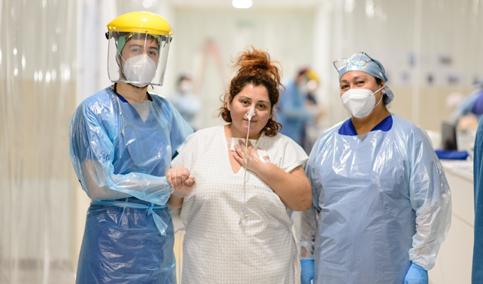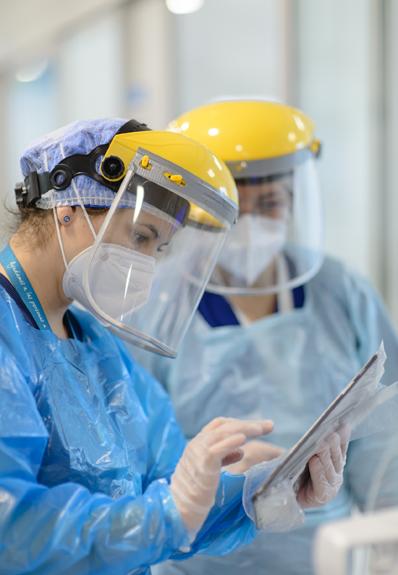
9 minute read
I love what I do – I always wanted to be a nurse
It has been shown that Medical safety communication can be A lot of the ward team (nurses, technicians effective in many ways, that and anaesthetists), trained up and we were able to put together mixed teams: experts technology should be our with newly trained staff, to balance things main support, that digital out. Also, we set up a very successful position of technical visitor for nursing, made up of transformation could get senior nurses in intensive care unit. They faster than it has been would make daily visits to new areas of the because of emergencies such icu and talk to the nurses, making sure that all clinical safety measures were in place. We as this one. We can only drew up a checklist, including key aspects react appropriately when we unite and work together for a that we called “the non-negotiables”. We also made courtesy calls. We would go through the clinic with our lawyer and if common objective. we saw someone not using their ppe correctly we would teach them. Some got annoyed, but it was part of the strategy, and we used the situation to raise awareness and remind people that it was a standard and it had to be followed. At the same time, we made a WhatsApp video on how to use the ppe. At one point we even put up mirrors to help people use ppe correctly.
Dealing with the emotional impact
I think at the beginning we didn’t realise the extent of the emotional impact on our teams. We were of course concentrating on what our patients were going through, who were mainly elderly adults, having to die far from their families. They weren’t allowed anyone with them due to the preventive measures or because they were brought in by ambulance from other health centres and their families arrived too late. In these situations, our teams were the ones who accompanied them on the journey from life to death. They got very emotionally involved, but they had to go on, because the situation wasn’t letting up. I can remember many such moments, and it always makes me emotional. After that, we came up with a plan for someone from the family to be there when the prognosis was not good, and we trained them in the correct use of the ppe. So we managed to balance prevention with having someone there for the patients. That was a very important measure and I think it helped ease the emotional burden on our teams. We have also brought in various initiatives to support the clinical teams. Every weekend people from the leadership teams go in pairs to visit the units, talk to the staff, make suggestions, provide snacks in addition to the normal meals and to thank them for their dedication and efforts. We have also provided psychologists to support our teams, to help them and be there for them when they need us. We also have a support line, which they can call whenever they need us. Another initiative that has gone really well, in emergency, is that each day we start with a safety pause when the shifts change. Teams can tell us if they are feeling low on energy and in talking about it everyone else is put on the alert. The psychological support is also available for patients and families. The care teams are grateful for that, because it means they can focus on the technical jobs, knowing that the families and patients can be comforted by experts. As healthcare professionals, we are prepared to support and focussed on saving lives. We love to help our patients improve, get better and be healthy again. But now, a lot of the time, we have had to understand that this is not possible, and our role has been to be there for them and give them a good death – ie, without pain, calm, knowing that we did all we could. Many times, the people who were by their side prayed or were simply there for them to help them pass from life to death – our auxiliaries, nurses, doctors, therapists. As well as having to deal with more patient deaths than usual, there was the fear of getting infected. In most cases, it wasn’t just about them, but about how they might pass it on to their families and their families get sick. Statistically, they knew that if they got sick, the potential for it being serious was low, because most of them are young people at low risk, but there was always the risk of passing it to their families.
Team absences
We had people of sick with the disease and people quarantining, and that was difficult to deal with at the beginning. Once we got the flows working better, we had more control and we were able to watch for surges in different units and intervene quickly. For those tasks, we got together working teams who, due to company policy, were sent home to protect themselves because they were at risk or vulnerable: pregnant women or people with diseases of the immune system. We covered these absences with our part time staff or with agency staff. We had people available, we just needed to qualify and train them. I remember an auxiliary who worked part time with us: I can’t begin to say how impressed I was with the way they worked, the atmosphere, and I had never seen such dedication at such a young age. I have worked for over twenty-three years and had never seen that. It was as if all the patients were their father or mother, even worrying about whether there was a wrinkle in the sheet that could hurt the patient. That made me feel that we were meeting our objectives, looking after the patients and helping our teams do their work as well as possible.
Our families, unconditional support
I must also talk about how the families of all our teams have played a fundamental part in all of this. They may not be seen, but they give their time so that mama, papa, brother or children can look after those who are alone, during the day, the night and the weekend. My husband is a doctor. He has been through what I have. But he was able to organise his time to be at home more and give more time to our daughters, helping them with the new home school routines. It was difficult to start with, but they soon got used to it. I talk to my daughters a lot, telling them stories, telling them what is going on. I want them to know what their mama does every day and why I have to spend so many hours at the hospital. At the beginning of July, I got infected with Covid, along with everyone at home. Thankfully, none of us were seriously ill.
Creative solutions
Creativity has helped us deal with problems that have arisen from the extra restrictions of the pandemic. Problems such as: keeping vigilant and keeping down entry into the rooms in order to avoid the spread of the virus. We have put in extensions and pumps and ventilation equipment outside the rooms, which has helped us reduce the exposure of our staff. Another example of creativity which we set up together with the customer experience department was to encourage patients’ families to send them messages printed in big letters, which we stick on the windows of their rooms so they can see them. That was really important for the people in hospital, and helped them feel less alone. Another idea our teams had, to deal with the damage caused to peoples’ skin because of using masks all the time, was to make caps with buttons they could fix onto. Overall, it has been a time of creativity, lots of different ideas of how to deal with big problems and challenges faced every day. That was when we realised it was important and necessary to give visibility and recognition to our professionals. To tell the world what nurses, midwives and all healthcare teams do, but also to show them all the skills that are not always recognised and that are part of their deep commitment to the wellbeing and care of others. Without this commitment and passion they put into their work, we wouldn’t have been so successful. Bupa Chile has set up a working group to prepare for the celebration of the International Year of the Nurse and the Midwife, led by the Medical Management and coordinated together with Sanitas, which had to modify its initial programme because of the pandemic. In this context, a book of recognition is a new way of commemorating such a special year. The idea of this book of stories snowballed. Everyone we shared the idea with supported us and brought in more ideas. We started enthusing others, we shared the ideas with nurses in Spain and they loved it! The manager of the clinical sector encouraged us and gave us the opportunity to present the book project to the Bupa Chile board, and we did that. We have a really united committee. They were really excited about the ideas and proposals and brought in new ideas too. Soon we had everyone in agreement with the project.
To tell the world what nurses, midwives and all healthcare teams do, but also to show them all the skills that are not always recognised and that are Telling our stories This has been an amazing experience and we part of their deep commitment should pass it on to those who will carry the to the wellbeing and care of torch into the future, helping them do things others. right. If they can act based on evidence, they can act more quickly and confidently. During the pandemic, we took part in and organised various webinars about the pandemic and its different aspects. It was always really useful and enriching to hear and learn about others’ experiences and see the evidence that science has made available to the world and use it in our own protocols and guidelines.
This has been an amazing experience and we should pass it on to those who will carry the torch into the future, helping them do things right. If they can act based on evidence, they can act more quickly and confidently.
There are certainly a lot of things we will do differently in the future. For example, we have action plans for emerging diseases and segmentation measures to prevent infection. It has been shown that communication can be effective in many ways, that technology should be our main support, that digital transformation could get faster than it has been because of emergencies such as this one. We can only react appropriately when we unite and work together for a common objective.�











